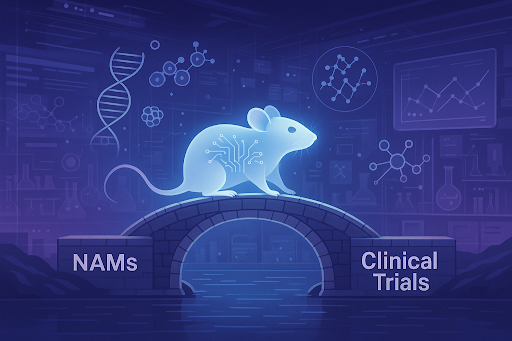How to Design Smarter In Vivo Studies That Bridge NAMs and Clinical Trials in Oncology

In a major shift toward modernizing drug development, the U.S. Food and Drug Administration (FDA) has signaled support for reducing reliance on animal testing by promoting the use of more human-relevant methods, including AI-powered computational models and New Approach Methodologies (NAMs)1. Through its collaboration with the Interagency Coordinating Committee on the Validation of Alternative Methods (ICCVAM), the FDA is accelerating the validation and adoption of these innovative approaches.
This change is particularly relevant for investigational new drug (IND) applications, where the FDA now encourages the use of NAMs-generated data and, in some cases, real-world evidence from international regulatory bodies with comparable standards.
However, while the FDA Modernization Act 2.0 enables non-animal methods when scientifically justified, it does not eliminate the need for animal studies altogether. In oncology, where complex biological interactions are central to treatment outcomes, in vivo animal models remain critical for confirming translational relevance and safety.
The challenge for preclinical teams is clear: conduct fewer animal studies but design them smarter, with strategic alignment to NAMs and downstream clinical endpoints.
Here's how to design in vivo studies that effectively bridge NAMs and clinical research, while meeting modern expectations for ethics, efficiency, and scientific rigor.
Step 1: Define the Translational Purpose
Before you start designing, get clear on what your in vivo study needs to prove beyond what NAMs already showed.
Ask:
- What are the limitations of our NAM data?
- What human-relevant outcomes still need to be modeled (e.g., immune response, systemic effects)?
- How will this study reduce uncertainty ahead of clinical trials?
This ensures the in vivo study serves a clear translational objective, not just a regulatory checkbox.
Step 2: Start with a Literature-Based Rationale
Avoid reinventing the wheel. A strong in vivo study design starts by mining existing preclinical literature.
Search for:
- Similar NAM-to-in vivo transitions
- Prior in vivo models with high clinical correlation
- Proven endpoints relevant to your therapeutic hypothesis
This helps you justify your in vivo model choice and align with FDA expectations for reducing unnecessary animal use.
Step 3: Choose In Vivo Models That Bridge, Not Duplicate
Don’t just repeat your NAM in vivo. Use animal studies to complement and extend what your in vitro and alternate models can't answer.
Consider:
- Immunocompetent models if immune response is critical
- Xenografts vs syngeneic in vivo models based on mechanism of action
- Pharmacokinetics or toxicity assessments that NAMs can’t replicate2
Think of in vivo as your bridge to complexity, not a mirror of your NAM.
Step 4: Tighten Scope, Maximize Insight
With fewer animal studies expected, each study should be tightly scoped and insight-rich.
Tips:
- Limit to the most relevant in vivo models and endpoints
- Integrate multiple NAM outputs to guide design
- Use fewer animals, but optimize timing, dosing, and measurement frequency
Well-scoped doesn’t mean shallow, it means strategic.
Step 5: Document for Cross-Functional Buy-In
Your study rationale should be clear not just to preclinical teams, but also to:
- Clinical development
- Regulatory affairs
- Investors or partners
Include:
- What NAMs showed
- What the in vivo will validate
- Why this bridge matters
This improves internal alignment and smooths FDA regulatory or stakeholder conversations.
Design Smarter In Vivo Studies That Truly Bridge the Gap
By using in vivo models to fill the translational gaps NAMs can’t reach, your oncology R&D becomes faster, more ethical, and more aligned with modern clinical demands.
Schedule Your Free Demo today to shift through literature and find the best in vivo study for your IND application.
References
- FDA Modernization Act 2.0 and Alternative Methods Policy. FDA Policy on Reducing Animal Testing in Preclinical Safety Studies. 2025.
- Citeline, Regulatory, Pink Sheet. Animal Testing Alternatives: US Pharmacopeia On Its Testing Transition. July 15, 2025.


.png)
.png)
.avif)
